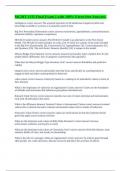MGMT 1135 Final Exam || with 100% Error-free Answers.
intelligence correct answers The acquired repertoire of all intellectual (cognitive) skills and
knowledge available to a person at a particular point in time.
Big Five Personality Dimensions correct answers extraversion, agreeableness, conscientiousness,
emotional stability, openness to experience
HEXACO model correct answers The HEXACO model is an alternative to the Five-Factor
Model. The HEXACO model includes six traits, five of which are variants of the traits included
in the Big Five (Emotionality [E], Extraversion [X], Agreeableness [A], Conscientiousness [C],
and Openness [O]). The sixth factor, Honesty-Humility [H], is unique to this model.
Meyers-Briggs Type Indicator correct answers measures personality types; explains how & why
people behave differently; lists 4 categories of preferences (& opposites)
What does the Meyers-Briggs Type Inventory lack? correct answers Reliability and predictive
validity
integrity tests correct answers personality tests that focus specifically on a predisposition to
engage in theft and other counterproductive behaviors
value system correct answers a hierarchy based on a ranking of an individual's values in terms of
their intensity
What is the importance of values for an organisation? correct answers Values are the foundation
of attitudes and motivation that influences perceptions and behaviour.
Rokeach Value Survey correct answers classifies two sets of values (terminal and instrumental),
each with 18 individual value items
What is the difference between Terminal Values vs Instrumental Values correct answers terminal
values refer to desired end states whereas instrumental values refer to modes of behaviour
Schwartz's Value Theory correct answers values are motivational in that they represent broad
goals that apply across contexts and time
What are the dominant work values of Baby Baby Boomers? correct answers Success,
achievement, ambition, and loyalty to career
What are the dominant work values of Generation Xers? correct answers Work/life balance, team
oriented, dislike of rules, and loyalty to relationships
What is the role of a manager within an organisation? correct answers To achieve goals through
other people. (ex: make decisions, allocate resources and direct the activities of others)
,What are the five main management functions? correct answers Planning, organising,
commanding, coordinating, and controlling
evidence-based management correct answers translating principles based on best evidence into
organizational practice, bringing rationality to the decision-making process
workforce diversity correct answers the concept that organizations are becoming more
heterogeneous in terms of gender, age, race, ethnicity, sexual orientation, and inclusion of other
diverse groups
ethical dilemma correct answers a decision that involves a conflict of values; every potential
course of action has some significant negative consequences
withdrawal behavior correct answers the set of actions employees take to separate themselves
from the organization
task performance correct answers the combination of effectiveness and efficiency at doing your
core job tasks
surface-level diversity correct answers differences in easily perceived characteristics, such as
gender, race, ethnicity, age, or disability, that do not necessarily reflect the ways people think or
feel but that may activate certain stereotypes
deep-level diversity correct answers differences in values, personality, and work preferences that
become progressively more important for determining similarity as people get to know one
another better
Discrimination correct answers Behaving differently, usually unfairly, toward the members of a
group.
Diversity Management correct answers the process and programs by which managers make
everyone more aware of and sensitive to the needs and differences of others
How can organisations implement diversity management? correct answers Through fair and
objective recruiting and selection policies and training and development practices.
cognitive dissonance correct answers an unpleasant state that arises when a person recognizes the
inconsistency of his or her actions, attitudes, or beliefs
What are the most powerful moderators of the attitudes relationship? correct answers The
importance of the attitude, its correspondence to behaviour, its accessibility, the presence of
social pressures, and whether a person has direct experience with the attitude.
job satisfaction correct answers a positive feeling about one's job resulting from an evaluation of
its characteristics
, job involvement correct answers the degree to which a person identifies with a job, actively
participates in it, and considers performance important to self-worth
psychological empowerment correct answers employees' belief in the degree to which they affect
their work environment, their competence, the meaningfulness of their job, and their perceived
autonomy in their work
organisational commitment correct answers The degree to which an employee identifies with a
particular organisation and its goals and wishes to maintain membership in the organisation
percieved organizational support correct answers The degree to which employees believe that the
organization values their contributions and cares about their well-being
employee engagement correct answers an individual's involvement, satisfaction, and enthusiasm
for work
What are the two approaches to measuring job satisfaction? correct answers Single global rating
- response to one question: 'all things considered, how satisfied are you with your job?'
Summation of Job facets - more sophisticated, identifies the key elements in a job (such as the
nature of the work, supervision, present pay, etc) and respondents rate these on a standardised
scale
What are some examples of potential causes of job satisfaction? correct answers Environment of
the workplace, interdependence, feedback, social support, and interaction with colleagues outside
of the work place.
exit correct answers dissatisfaction expressed through behavior directed toward leaving the
organization
voice correct answers dissatisfaction expressed through active and constructive attempts to
improve conditions
loyalty correct answers dissatisfaction expressed by passively waiting for conditions to improve
neglect correct answers dissatisfaction expressed through allowing conditions to worsen
What are the two dimensions of the exit-voice-loyalty-neglect framework? correct answers
constructive/destructive and active/passive
How can managers raise employee satisfaction? correct answers Evaluate the fit between the
employee's work interests and the intrinsic parts of his or her job to create work that is
challenging and interesting to the individual
What is the relationship between pay and job satisfaction? correct answers High pay alone is
unlikely to create a satisfying work environment




